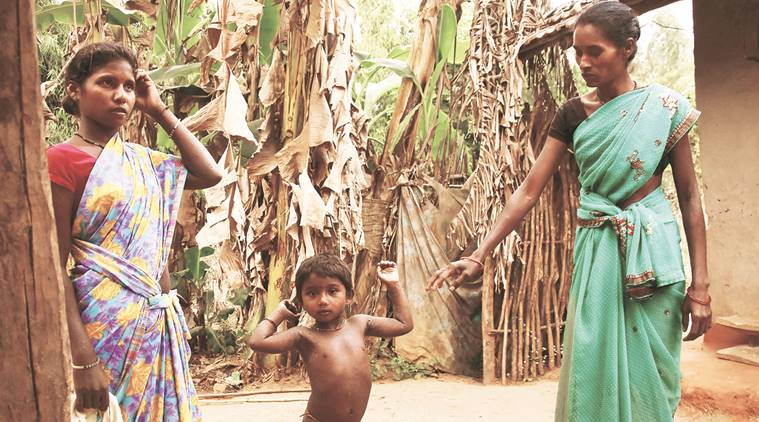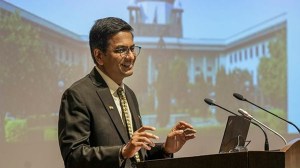- India
- International
Their ASHA
Shakuntala Anandrao Madavi is part of an 11-lakh force that is the face of rural healthcare. Their nearly year-long protest shows a lot ails the system.
 Shakuntala covers 4-5 km daily on her purple cycle, visiting every hut in village Ranipudur; assessing the skin infection of five-year-old Kajol. (Express photo by Monica Chaturvedi)
Shakuntala covers 4-5 km daily on her purple cycle, visiting every hut in village Ranipudur; assessing the skin infection of five-year-old Kajol. (Express photo by Monica Chaturvedi)
Every time there is an ailing villager in Bhamragad, Gadchiroli, Shakuntala Anandrao Madavi mounts her purple bicycle, rides a kilometre on an uneven hilly patch, and crosses dense forest into a nearby field to get mobile network. From there she calls the nearest sub-centre, 3 km away, for an ambulance. “When there is no network, we fix a charpoy between two cycles, load the patient, and ride to hospital,” the 37-year-old says.
Last year, Shakuntala won the best accredited social health activist (ASHA) award in the tough Gadchiroli terrain, known for being a Naxal hotbed. But when ASHA workers held protests across the country, from Haryana in January to Madhya Pradesh in October, seeking a fixed salary and better incentives, Shakuntala too joined in, participating in a jail-bharo march in August. On September 11, Prime Minister Narendra Modi announced a hike in honorarium during Mann Ki Baat.
Vinod Zogde, the state deputy president of the Maharashtra Rajya Aarogya Khate Asha Sangathana, says it’s far from enough. While the hike is insignificant — from Rs 100 for certain schemes to Rs 200 — the incentives that get ASHA workers extra income have been increased in just five schemes.
 Maharashtra Directorate of Health Services director Dr Sanjeev Kamble says the state government has started paying hiked incentives to ASHA workers. “We will have to check if Vidarbha region is receiving it.” (Express photo by Monica Chaturvedi)
Maharashtra Directorate of Health Services director Dr Sanjeev Kamble says the state government has started paying hiked incentives to ASHA workers. “We will have to check if Vidarbha region is receiving it.” (Express photo by Monica Chaturvedi)
Shakuntala earns Rs 2,500-3,000 per month, for working six-eight hours a day, travelling an average of 4-5 km on her cycle, visiting every hut in village Ranipudur, that is dominated by Madia Gond tribals, to monitor 73 health programmes.
The National Rural Health Mission, launched in 2005, established ASHA workers as the first point of contact for rural health services, designating a population of 1,000 people under each. Shakuntala joined the over 11 lakh workforce in 2009.

“My farm had poor produce. I thought I’ll contribute to the family and serve people,” she says. The six-acre farm on which her family cultivates rice suffered crop failure last year too due to scanty rainfall, with the annual income dipping from Rs 50,000 to Rs 30,000.
So every morning, Shakuntala wakes up at 4, finishes cooking and bathing by 7 am, works with her husband on their farm for an hour, and around 8 am, sets off on the purple cycle from their thatched-roof hut. For the next four hours, Shakuntala visits every child aged less than six to check for illness or malnourishment. Until September, of 82,692 children screened in Gadchiroli, 21.3 per cent (17,618) were found malnourished.
Since the local anganwadi worker comes rarely, daily meals for children remain irregular in these parts. Skin infections are common, as is malaria. It took years, Shakuntala says, to convince villagers not to use the mosquito nets given by the Health Department to catch fish.
At the hut of Kishor Atra, Shakuntala checks if his daughter Kajol’s skin infection has subsided, and if an ointment given by her for the five-year-old has been applied. Walking to another hut, she murmurs, “I’ll have to take her to hospital tomorrow.”
At the next hut, Mira Maruti Shriram and daughter Sakshi have fever. A day before, Shakuntala had given them paracetamol.
“If a child is ill, my entire day is spent taking her to a sub-centre,” she says. There have been days when she has ended up spending nights out too, getting a child admitted to a nutrition rehabilitation centre at Gadchiroli town, 180 km away. The primary health centre is 18 km and two shallow rivers away.
If there is no child requiring medical aid, Shakuntala returns home in the afternoon to finish household chores and work in the field. Her daughter is in Class X, while her sons are seven and 10. All study in tribal schools.
In the evening, after 5 pm, Shakuntala sets out again, this time on foot.
Once every month, she also rides to the sub-centre to stock up on ORS, paracetamol, and folic acid tablets, kept at her hut. Talking about the low renumeration, the 37-year-old mentions a tuberculosis patient, 55-year-old Baburao Somaviladi, whom she monitored every evening for eight months, until October. “He had dropped out of TB treatment, so I had to ensure he took his medicines on time. But he died finally,” she says. Had he lived and finished his treatment, she would have received Rs 1,000 — the incentive for ASHA workers to ensure TB patients complete their treatment.
The incentives vary from state to state. In Maharashtra, an ASHA worker gets Rs 600 for every pregnant woman who delivers in hospital, Rs 200 for a sterilisation, Rs 200 for getting a malnourished child to hospital, and Rs 150 for every child who is immunised. In a year, Shakuntala may end up monitoring three to four pregnant women, and newborns.
Since November, Shakuntala has had an added responsibility — measles and rubella vaccinations. “It is difficult to convince parents that immunisation would have no harmful effects,” she says. There are also other programmes like palliative care, geriatrics and mental health programme, with this region (part of Vidarbha) reporting among the maximum cases of farmer suicides in Maharashtra.
Having got 69 children vaccinated in Ranipudur, Shakuntala talks about the time tribals would not listen to her on either going to hospital for deliveries or getting children vaccinated. Now villagers call her “ASHA tai” and help her when a patient needs to be taken to hospital. Often, she ends up spending own money on that. Plus, while Shakuntala spends Rs 99 on mobile recharge every month, the state government reimburses only Rs 50.
Maharashtra Directorate of Health Services director Dr Sanjeev Kamble says the state government has started paying hiked incentives to ASHA workers. “We will have to check if Vidarbha region is receiving it.”
But Shakuntala says she can’t wait for long. Her daughter Prananjali is giving the Class X board exams this year, and she says, “Her books will cost Rs 2,000.”
Fulfilling one of her last tasks for the day, Shakuntala makes entries in a daily register, that also has details of the period cycle of each woman she monitors, to track pregnancies. As her mother-in-law complains about her pay, Shakuntala sighs, “Majboori hai to kaam kar rahein hai (We work because we have no choice).”
Buzzing Now
Apr 20: Latest News
- 01
- 02
- 03
- 04
- 05







































